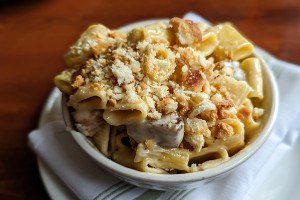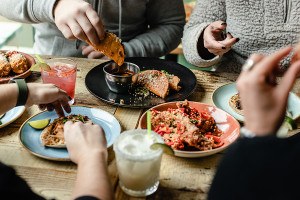Dining Out: A Room of Her Own
Rialto has always been something of a club. The whole Charles Hotel complex, including the underrated, always reliable Henrietta’s Table, is a well-ordered world of its own, a kind of gated community within Harvard Square. The old-money Cantabrigians and Harvard grandees (not to mention the Clintons) come to the hotel’s class-act restaurant, Rialto, because they know they’ll be recognized and treated well. Formerly, much of this was thanks to über-hostess Michela Larson, who had a bead on their sensibility from the minute she opened Rialto almost 13 years ago. But I attribute the lasting appeal to Richard Friedman, one of a vanishing breed: the local, interested owner.
All of which means Rialto has been fairly food-proof, though of course, given everyone’s high standards, the food was always noteworthy. Jody Adams, the opening chef, came into her own here—after apprenticing with the best in town, Gordon Hamersley and Lydia Shire—and now has the place to herself, her former partners (Larson and Gary Sullivan) having gone their own ways. She has torn into her new role with delight, working with Maryann Thompson on a fresh interior design in which whites and warm sand and topaz colors replace the one-time rich, dark palette. It’s as if someone in, say, London threw open a set of glass-paned doors and was magically surrounded by Positano. The sweeping room is elegant, sunny, restful—a place you just want to be.
The menu has undergone a renovation, too. Where Rialto started out with big Mediterranean flavors, including many from Provence and Spain, the stated emphasis now is on Italy. The new menu is divided into four courses, with the second (mostly pastas and risottos) a kind of swing course that can be first or main, even if the intention is the Italian antipasti-primi-secondi order. The overall effect, though, is less Italian than streamlined Mediterranean, with Adams’s imagination roaming free and ingredients getting more attention.
In its first months, the food was not as consistent as I expected, with some dishes practically poetry and others surprisingly heavy—and too many of them oversalted. With a bit of discretion, however, I was able to eat well. Two of the most successful dishes, the ones that make me look forward to a perfected retooling, are first courses: roast asparagus with peas and pistachios ($11) and octopus and white bean salad ($12). What made the asparagus was the melting stracciatella draped over it, a string cheese that is beautifully creamy and ever so lightly sour (the name means “little rag,” for the cheese’s torn fibers). Adams imports it from Italy, a step more chefs and cheese shops should take. She intuited that peas and chopped pistachios would pair divinely with lemon zest, mint, olive oil, and capers. When I asked where she had learned this take on the classic Veneto spread gremolata, she jokingly replied, “In a dream.” It’s a sign of her food sense: The dish was spring on a plate.
Octopus is one of the slightly offbeat ingredients with which Adams has long had a special affinity, and in her hands it is unfailingly tender, not tough (as it frequently can be), and full flavored. This version was braised and seared to order at the “antipasti station,” the long counter that in Rialto’s original incarnation was an often-unused dessert area. Accompanying the octopus were white beans, a common pairing but here given a kick from hot pepper flakes and some good, garlicky greens. Everything went together and said, You’re in the Mediterranean—the broad swath where Adams is still most at home.
Another ingredient in which Adams always brings out the best is rabbit. On the new menu it’s braised with olives, figs, and pine nuts ($32), a slight twist on the frequent pairing of rabbit or duck with olives. As usual, her rabbit is meaty and tender. So was the quail ($30), positively billowing with a stuffing of polenta, currants, and pine nuts. For anyone homesick for the old lineup, the menu includes “Rialto Classics” that show off Adams’s most honed skills. After all these years, it’s still impossible to go wrong with her justly famous slow-roasted Long Island duck with roasted fingerlings and Sicilian olives ($36), a lush, huge-flavored dish. (It’s also impossible for Adams to remove the dish from rotation; see “The 86 List.,”)
Contrast those with the wrong turns from the revamped sections of the menu. For instance, it’s a great idea to offer prosciutto from Iowa rather than Italy, but the miniature slices of La Quercia prosciutto ($13), served with roasted mushrooms, pine nuts, and fava bean purée, were shardlike and virtually without flavor. It’s also a great idea to make wide pappardelle noodles with farro, a fashionable ancient precursor to modern-day wheat and whole-wheat and buckwheat flours. Whole grains are the latest dietary must, and they give the noodles, presented in an open-face lasagna ($13), a lovely wheat color. But even with a creamy mascarpone and sheep’s-milk ricotta sauce to soften them, and the lightly woodsy taste of spring morels to complement their nuttiness, the noodles were tough and drab. The cod with garlicky crumbs, slow-baked tomatoes, and brandade from homemade salt cod ($30) was a terrific concept—a Mediterranean overlay on a Boston standard—but the fish had a mushy texture and so little flavor that it remained almost uneaten at a table of six. The spaghetti and lobster ($18) has the makings of a signature dish, with gutsy flavors that reminded me of a Lydia Shire classic from years ago at the old Bostonian Hotel. Adams told me she had tasted something like it in Rome, and then came up with her own take: charred red and green tomatoes as a base, and plenty of zest from ginger and saffron and a drizzle of peppery lobster oil at the end. The architecture is solid, but when I tried it, the pasta was undercooked and the sauce so salty I had trouble tasting the lobster meat.
All the lines are right at Rialto—it’s just a matter of settling in and tuning. Desserts aim for simplicity, yet are sometimes a bit heavy and miscalculated (the olive oil cake with lemon and pine nuts, served with rosemary gelato and pineapple, $9, is an example). Sometimes, though, they are wonderfully clear. I hope Adams always keeps on the menu a mascarpone cream tart with grappa-blueberry compote and lemon-buttermilk sherbet ($9)—Susan Abbott, the pastry chef, can switch out the compote by season, but she mustn’t lose that tart, refreshing sherbet. It’s exactly the way to end a meal at this refreshed local landmark.


